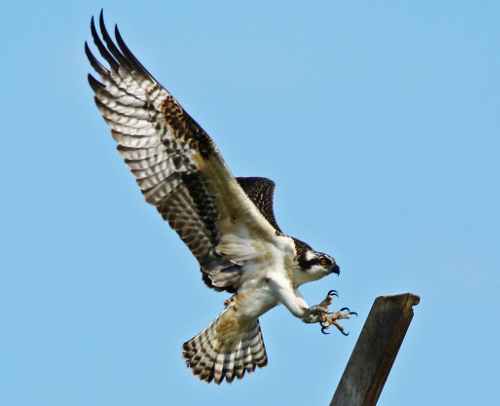Detroit River-Western Lake Erie Basin Indicator Project
Osprey Nesting Success in Southeast Michigan
Authors
John Hartig, University of Windsor, Great Lakes Institute for Environmental Research, jhhartig@uwindsor.caBackground
Osprey (Pandion haliaetus) are found worldwide and are a common sight soaring over shorelines, patrolling waterways, and standing on their large stick nests with their white heads gleaming. Also known as “fish hawks,” “river hawks,” and “sea hawks,” they are one of the largest birds of prey in North America with a nearly six-foot wingspan. They feed almost exclusively on fish and are considered a good indicator of aquatic ecosystem health.
Osprey is a superb predator on fish. While flying or hovering some 30-100 feet above the water surface, they plunge feet-first into the water in search of their prey. They use gripping pads on their feet and curved claws to help pluck fish from the water and carry them off for great distances.
As with many other top predators like Bald Eagles and Peregrine Falcons, the use of the pesticide DDT in the years after World War II negatively affected Osprey populations. The biomagnification of DDT and other pesticides in the Osprey’s bodies resulted in brittle, extremely fragile eggshells. The body weight of the parents broke the eggs, and very few young were born. DDT use was subsequently banned in Michigan in 1969 and the remainder of the U.S. in 1972.
As a result, Osprey were listed as threatened in Michigan at one time (Michigan Department of Natural Resources 2011). After Michigan’s Osprey Reintroduction Project (1990-2000), the species has rebounded enough to be upgraded to a species of special concern. Protections offered by the Migratory Bird Treaty Act also helped bolster osprey populations.
Status and Trends
In the early-1960s, the Osprey population in Michigan was rapidly declining (Postupalsky 1977). By 2002 there was only one active nest in southern Michigan. To restore the osprey population, Michigan Department of Natural Resources, with assistance from Huron Clinton Metropolitan Authority, the Detroit Zoological Society, and DTE Energy, established the Osprey Reintroduction Project of Southern Michigan (Michigan Department of Natural Resources 1998). The goal of this Osprey Reintroduction Program was 30 nesting pairs in the southern half of Michigan’s Lower Peninsula by 2020. This project involved moving 50 chicks from the northern parts of the state to areas in southern Michigan.
There are now more than 75 known nests in the southern Lower Peninsula, plus dozens of nests in the northern Lower Peninsula and the Upper Peninsula. Michigan Osprey, a citizen organization devoted to tracking and restoring the osprey population, has reported that the goal of 30 nesting pair in the southern half of the Lower Peninsula was achieved in 2010, 10 years ahead of schedule. In southeast Michigan alone (e.g., Wayne, Macomb, Oakland, Livingston, Washtenaw, Monroe, and St. Clair counties), there were 38, 50, and 52 nesting pairs in 2015, 2016, and 2017, respectively (Figure 1). It is interesting to note that in 2009 a pair of Osprey built a nest in a cell phone tower adjacent to the Gibraltar Wetlands Unit of the Detroit River International Wildlife Refuge along the lower Detroit River, representing the first time that Osprey have successfully nested in Wayne County since the 1890s.

Figure 1. An Osprey named Monroe Julie fledged from the Strong Unit of the Detroit River International Wildlife Refuge in 2016 (photo credit: Fred Drotar).
Clearly, this Osprey reintroduction program has been successful, but concerns remain. Osprey still need to be protected from killing or capture, especially in their wintering grounds in Florida, southwestern U.S., and Central America. For example, an osprey named Monroe Spark that fledged from the Detroit River International Wildlife Refuge’s Strong Unit in 2013 was fitted with a backpack satellite transmitter that tracked it to Cuba where it was probably killed by a fish farmer. This shows that international efforts are needed to protect this species. Some protection is provided Osprey protected under the Migratory Bird Treaty Act of 1918, however, greater international cooperation is needed.
Research/Monitoring Needs
The return of Osprey in southern Michigan is clearly a conservation success story. Nearly absent from much of Michigan as a result of exposure to DDT and other pesticides, southern Michigan’s Osprey population continues to rebound.
Yearly monitoring of Osprey should continue throughout the Detroit River and western Lake Erie watersheds under the direction of Michigan Osprey and with support from the Michigan Department of Natural Resources and the U.S. Fish and Wildlife Service. Special emphasis should be placed on minimizing contaminant exposures, tracking health status, and protecting habitats to ensure long-term population sustainability. Contaminants of concern include organochlorine compounds and heavy metals, as well as emerging new generation compounds. Furthermore, additional laboratory and field studies may be necessary to further clarify the role of environmental endocrine disruptors on reproduction in avian populations. Osprey banding and tracking using GPS-equipped backpacks should continue to better understand seasonal migration patterns and daily movements of the young birds.
References
- Michigan Department of Natural Resources. 2011. Michigan’s Wildlife Action Plan: Highlights of the First Five Year. Lansing, Michigan, USA.
- Michigan Department of Natural Resources. 1998. Osprey recovery plan. Lansing, Michigan, USA.
- Postupalsky, S. 1977. Status of the Osprey in Michigan. Pages 153-165 in J.C. Ogden, editor. Transactions of the North American Osprey Research Conference. US Department of Interior, National Park Service, Series 2, Washington, D.C., USA.
Contact Information regarding Osprey Nesting Success in Southeast Michigan
John Hartig
University of Windsor, Great Lakes Institute for Environmental ResearchE-mail: jhhartig@uwindsor.ca